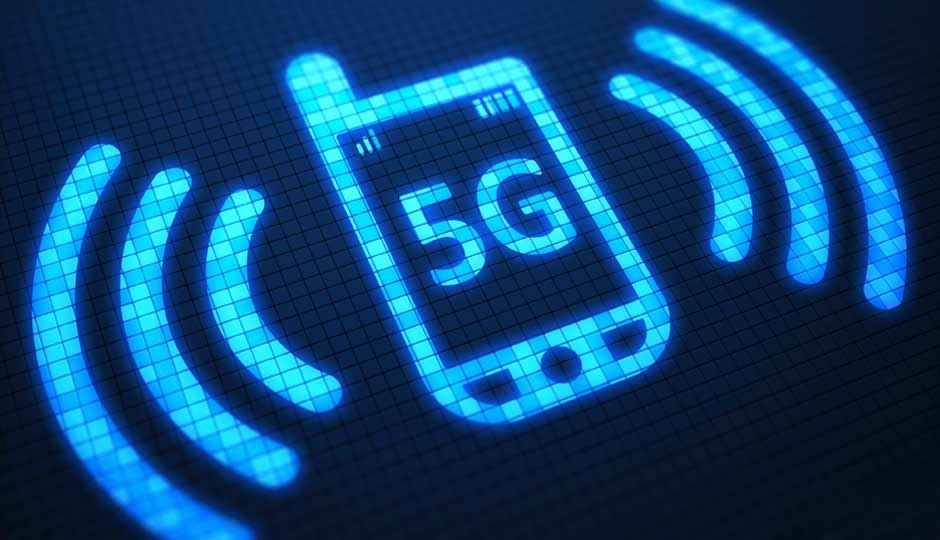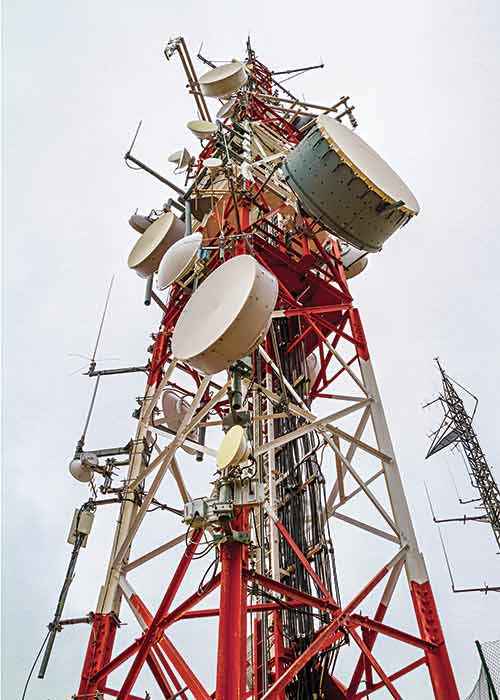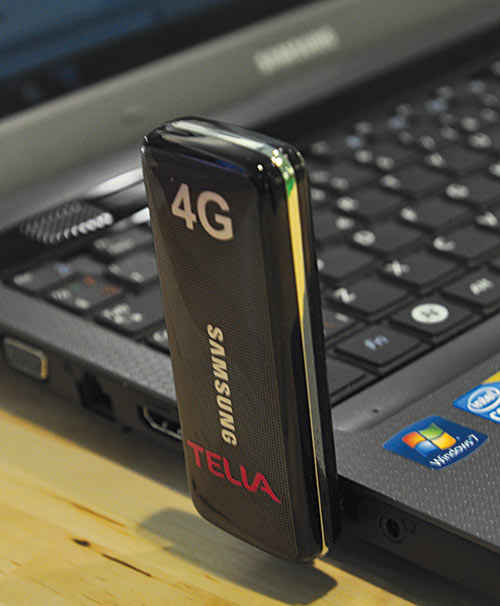5G: The Internet of the Future

The race for 10 Gbps speeds is the next big step towards the evolution of 5G. So, before the internet of the future arrives, let us delve deeper into what it entails.
As India progresses towards a pan-India 4G network rollout, the research behind the fifth generation of cellular broadband technology is rapidly moving towards completion, called 5G at it’s current state. 5G simply stands for ‘fifth generation’, and it’s the upcoming standard of mobile communications which suggests that it will revolutionise how we interact with technology, moreover how technology interacts with us. So, what is 5G? Well, to be exact, it is not defined yet. It is rather, a very complex topic at the moment, since the properties and ingredients of the technology are still under consideration. However, currently, industry experts have chalked out some of its goals in the early stages of the conceptualisation of this upcoming technology. According to various organizations and research teams working on 5G, it will take at least another half a decade to become a global standard. 5G is supposed to bring lower latency, better and wider connectivity and best of all, super speeds of up to 10 Gbps. This is just the tip of the 5G iceberg as it is being conceptualised to be way bigger than the current 4G standard. It will not only help internet penetration in remote areas, but if the required goals are met, it will be an essential part of mission critical industries such as medicine and autonomous vehicles. 5G is also supposed to be a new chapter in security and a likely nurturer of big and small scale industries, which are likely to mushroom as we move towards a utopian, connected future.
But first, a history lesson on the “G”
To understand how mobile wireless technology works, we need to dive into the genesis of the technology. We need to get into the past of the technology, we need to understand why today’s technology won’t be enough to sustain the outgrowing demand of data and why 5G could be the solution which may enable us to be more connected and the world to be more automated. This will also help us understand why 5G is a much bigger deal than the existing 3G and 4G networks.
1G
Let’s start with 1G, the true first generation of mobile networks or wireless systems, which enabled consumers to connect with each other on a global level. Before this, there was IMTS (Improved mobile telephone service), which was severely expensive and extremely limited. A whole IMTS unit was as big as a briefcase and required a separate large antenna, plugged to a power source to place calls. This analogue technology evolved into 1G or AMPS (Advanced Mobile Phone System), which came into existence in the late 1980s. This carved the cornerstone for mobile telephony, reducing the briefcase size telephone to a handheld device. However, it had its set of problems. 1G had low capacity, poor voice links and no security. Voice calls were played back in radio towers and anyone with a radio scanner in the vicinity of the phone signal was able
to eavesdrop.
Fact: Bell Labs developed the AMPS or 1G standard and Motorola came out with the device to support it. This became the first commercially available mobile phone, the DynaTAC 8000X.
2G
To overcome the problems of 1G, a new standard 2G or GSM (Global Systems for Mobile communications) was introduced in 1991. Offering digitally encrypted phone calls, this standard was more secure and efficient than its predecessors, hence it was adopted world-wide. A few years later in 1995, SMS services were integrated within the technology which made it an even better standard. With 2G, phones became much smaller, battery efficiency was improved and voice clarity was better. But the times were changing and the internet was at the cusp of booming. Sadly, 2G with its 64Kbps theoretical speed of data transfer was not up for the task. This was the main hurdle in the research and development of the third generation.
Fact: The original iPhone featured cellular connectivity using GPRS and EDGE bands.
2.5G and 2.75G
Between the second and third generations, lies GPRS (General Packet Radio Service) and EDGE (Enhanced Data rates for GSM Evolution) which are otherwise known as 2.5G and the 2.75G standards respectively. These transitional standards were later developed over the older 2G standard and basically provided more data speeds than 2G which was good enough to check email or load a webpage, but still fell considerably short of the network speeds 3G could achieve.
3G
In 2001, the age of 3G dawned. It was a big upgrade from the 2G standard but it was an upgrade. Nonetheless, the new standard had upgraded audio codecs and some part of the older GSM architecture. 3G also brought a new standard called the IMT-2000 (IMT – International Mobile Telecommunication). With the introduction of 3G, things got complex because there are many technologies which are compliant with the IMT-2000 standard, but the one most important is UMTS. UMTS, otherwise known as the Universal Mobile Telephone System, is the widely used 3G standard offering global roaming as it is globally recognised by a majority of countries. The upgrade in audio codecs saw enhanced audio and video streaming, higher browsing speeds, faster data speeds, GPS support, video conferencing support and support for IPTV (TV through internet).
3.5 and 3.75G
Things started to evolve rapidly afterwards as the demand for faster internet speeds emerged. Soon, the 3.5G and 3.75G standards came into existence. These two standards otherwise known as HSPA and HSPA+ offered peak theoretical downlink speeds of 14Mbps and 168Mbps respectively. This was more than the 2Mbps downlink speeds 3G used to offer. While HSPA was metaphorically 3G on steroids, 3.75G was able to achieve much higher speeds and lower latency due to a new technology called MIMO (Multiple-input and Multiple-output), which set the ground for the 4G and LTE standards.
Fact: Some mobile operators are selling the 3.75G or HSPA+ plans as 4G because the real life speeds of the two are very close.
4G
4G, otherwise known as IMT Advanced, is a complete overhaul from the earlier standards. 4G is currently deployed in two forms, one is WiMAX (Worldwide Interoperability for Microwave Access) and LTE (Long Term Evolution). Out of the two, LTE, has a better adoption rate across the globe. It is also due to the fact that WiMAX supports voice calling via VoIP only and requires new deployments, whereas LTE is made to work with existing deployments. LTE is also slightly faster than WiMAX.
Key point: LTE is the long term evolution of UMTS which was upgraded over the 2G standard.
LTE-Advanced is the latest chapter in 4G. It’s faster than 4G and offers theoretical peak download speeds of upto 450Mbps over the theoretical peak download speeds of upto 300 Mbps achievable by LTE. This was a good enough reason to be excited about 4G finally coming to India. Although, you won’t get the theoretical speeds due to various physical and technical factors, it is still good enough to be excited.
5G = 2G + 3G + 4G + Wi-Fi + ?
By now you must have realised one thing. Every new generation is better than the previous one, and not by a small margin. With 5G, the theoretical download speeds are expected to hit 10Gbps, making it 100 times faster than 4G. Also, like all previous generations, 5G will incorporate all its previous generations within itself. Additionally, it will also include specific new technology architectural changes that haven’t been defined yet. Wi-Fi technology is also part of this heterogeneous equation and will play an important part in it. Wi-Fi derived technology will help the standard achieve that higher data transfer rate. While none of the main organizations working on the upcoming standard haven’t set a proper set of rules about what 5G should be, there is a wish list which is slowly gaining industry acceptance. These are some of the standards 5G is expected to meet:
1. 5G based technology is expected to handle a large amount data in tens of megabytes, catering to a group of thousands of people, without dropping or lowering network speeds. This would mean efficient and faster connectivity with speeds of upto 10Gbps.
2. It is expected to offer latency of less than 1 millisecond end-to end round trip delay. This could mean a sublime VR experience over network. It is also important for mission critical tasks. for example, a doctor operating remotely on a patient via the help of a surgical robot.
3. Supreme bandwidth of a 1,000 times per unit area, which can support a hundred thousand simultaneous active connections. For this, 5G could harness or evolve upon the current and previous gen technologies such as 2G, 3G, 4G and Wi-Fi.
4. It is being perceived that 5G could bring 99.999% availability which could effectively mean the highest connection rates between the cell towers.
5. 5G is also suggested to cover 100% of the geographical area. This could essentially offer better connectivity over remote terrain and rural areas. If the upcoming standard is able to achieve this goal in real life scenarios, it will become the most important factor in the growth of developing nations.
6. One of the drawbacks with 4G is that it is not battery efficient, but 5G may change that. Research teams are working to reduce the power consumption by up to 90% at the terminal end, which will in turn make the whole process cost effective. The power consumption at a user’s mobile level is also expected to go down which will make cellular devices last longer.
It is not guaranteed that these set requirements will be matched perfectly even by 2020, which is the expected year we might have some concrete technologies to support the above mentioned requirements. Albeit, early tests and studies in the field suggest that we are close enough.
Fact: 4G is likely to evolve and give us its transitional standards. 4.5G or as it is unofficially called LTE-Advanced Pro. In November 2015, HKT and Huawei successfully demoed the world’s first 4.5G network offering 1Gbps of speed.
Why do we need 5G?
The answer to that is quite simple. 5G is vital to solve critical technological problems and keep up with future innovations. Another factor is the exponential growth in the user base, which is predicted to balloon beyond the seven billion mark by 2020. The current generation technology is not powerful or efficient enough to handle this massive growth, comprising mostly of traffic generated by video consumption these days.
Beyond that, 5G could be the key to seamless integration of technology within our daily lifestyle, in a more automated world, where we strive to achieve by the end of this decade. Automated vehicles, IoT devices, 4K and 8K streaming, fast and responsive health care and emergency services, are just some of 5G’s countless use-cases. To accommodate all these varying needs, 5G is required. It’s benefits are far stretched out than any of the previous generations. From connecting billions of people to offering faster internet speeds, it has to do it all and do it well.
How will it be different from 4G?
First, the speed. Yes, if boffins in the research lab are able to crack the mentioned wish list, we might get 10Gbps connection speeds by the end of 2020. This means a Full HD movie of around 8GB in size will take just six seconds to download instead of the 6-7 minutes it would take over normal 4G connections. 5G also brings the promise of better coverage, meaning lower call drop rates and more connected devices, currently a major problem in India. On top of that, 5G is expected to be quite flexible in terms of its infrastructure, making it easier to be deployed under low-costs. If this becomes a fact, India will be able to connect at a more rapid pace than ever.
We can expect, that by 2020, technology will progress enough to make a bigger leap in remote computing and VR. It’s also safe to presume that communication will become extremely real-time, offering a tactile internet, where you would be able to not only see and listen to it but touch and feel it as well. Also, IoT and connected devices such as wearables, smart home appliances and even connected vehicles will become a more intrinsic part of the future. They will obviously require faster and more reliable networks to accommodate the surge in growth.
On a technical level, 5G is likely to use higher frequency bands which are currently being used by radar, satellites and military systems. This is the 30Ghz to 300GHz frequency band which is also called the millimeter-length wavelength. These waves are given consideration since they are open to huge amount of bandwidths and this spectrum is relatively less occupied compared to other spectrum bands in use. These can carry a large amount of data at higher speeds. However, millimeter waves are not perfect, their coverage is less than 300 metres, they don’t penetrate walls and become woeful with changes in atmosphere such as rain.
Many researchers are working on newer technologies based on Wi-Fi and other waveforms such as FBMC (Filter Bank Multi-Carrier), UFMC (Universal Filtered MultiCarrier), GFDM (Generalised Frequency Division Multiplexing), f-OFDM (Filtered – Orthogonal frequency-division multiplexing). Besides these, there are other waveforms under consideration as well.
Currently, no single waveform can support the wish list 5G is vying for and it is to be believed that in the end, a combination of wavelengths or an adaptive wavelength will be able to provide the required results. This also means, that scientists will have a to develop a whole new receiving and transmission architecture to accommodate all the features of the 5G standard. However, at the moment it’s still under development.
While companies like Ericsson, Nokia and Huawei are hosting demos of what they have achieved so far, it is still the early days for the technology. As years go by and 5G comes to life, it will fall to service providers to push and adopt the technology further. This will require new infrastructure at every stage. After all, 5G mobile communications are supposed to handle almost 1,000 times more traffic, 10Gbps of speed and super low latency of under 1ms.
How is the research going?
It all comes down to the research of the various aspects which will shape the mobile broadband of the future. As discussed, higher frequency bands are likely to be used and to counter the problem of smaller coverage, a new technology called ‘beam-forming’ has been widely accepted. The concept behind it is quite simple. Instead of broadcasting the signal in a wide area, concentrate the signal directly to the target device. Some new Wi-Fi routers use this technology and we might see an evolved variant of the technology in the upcoming 5G standard. This technology proposes to focus radio interface into beams which will make them usable over long distances. These beams must be directed towards the end user and since the service is required to be mobile and available to many, the corresponding combination of hardware and software has to track and stay connected to each individual in the vicinity. This is quite a task, keeping in mind that each cell can only support a certain number of beams at a time and that too, without dropping the quality of the network.
Fact: A cell is simply a geographical area covered by a cellular telephone transmitter. It can vary from 1KM to 30KM in diameter
The other technology which is being worked upon is MIMO (Multi-Input, Multi-Output). This technology requires the devices to be fitted with an array of antennas via which multiple radio connections can be made between the device and the cell tower. However, high-order MIMO has an issue, it causes radio interference. Hence, a new method or technology is required to transfer data via MIMO. This needs a new kind of radio network which can adjust its beam to take into account the specific orientation of the antenna at any given time. The idea of 3D MIMO is also being researched, which will allow beam-forming in 3D.
To counter the massive demands for data, an easier solution of dense networks is being considered. This means reducing the cell size. By reducing the cell size, and lowering the range, spectral efficiency can be improved as the capacity increases. However, this will also mean more number of base stations will be required, again increasing the cost incurred on the operator. So, research is being done to improve that.
Currently, the existing cellular communication uses two full-duplex form, FDD (frequency Division Duplex) and TDD (Time Division Duplex), which essentially means using two different frequencies to transmit and receive. In FDD, the network uses different frequencies to receive and transmit and in TDD, the transmission and reception is done at different times. However, both these methods are not completely efficient. So, a new full duplex method is in the works which will allow simultaneous transmission and reception on the same channel at the same time.
Work is also going on Multi-Radio Access technologies which will essentially allow devices to talk to the various radio interfaces and access points at the same time. It is likely to involve Wi-Fi, higher frequencies and currently used frequencies into the mix.
As mentioned earlier, 5G is likely to work on a higher spectrum using millimeter waves but our current research is inadequate to make the system work. Beyond this, there are other goals such as “1ms latency” which needs to be achieved and for that, the technology needs to evolve. There are multiple research teams around the world trying to solve that issue and are going forward towards different research paths. We just hope that by 2020, they actually make it a reality.
Hardik Singh
Light at the top, this odd looking creature lives under the heavy medication of video games. View Full Profile












